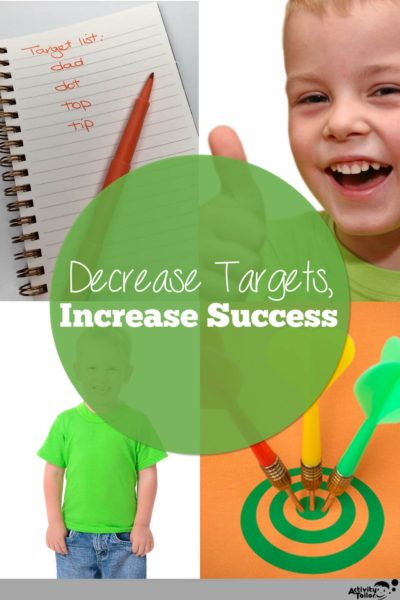
Decrease Targets, Increase Success
I’ll admit, I sometimes sit down to another session of articulation therapy feeling, well, bored. Even when the materials themselves are new, the sameness of the targets can make you feel like you’re in a never-ending cycle of Groundhog Day.
And it can be even worse for phonological processes because you’re already a little limited by vocabulary because these tend to be our younger students who don’t have a wide repertoire of words and we particularly want them to gain understanding about the differences a sound can make. Can’t do that if they aren’t sure what the word is anyway!
But this is all about you.
And if we want to really maximize success, we need it to be about them.
In Barbara Hodson’s classic text, Targeting Intelligible Speech, she emphasizes the importance of carefully selected targets over the quantity of targets. In fact, she recommends 12-15 words on the “listening list” and 2-5 targets for the child to practice for each processing target. You guys, 2 to 5.
This post may contain Amazon affiliate links. I receive a small commission, but there is no additional cost to you. I only recommend what I use!
Selecting Targets for Articulation and Phonological Processing Therapy
I had a little one this summer that needed to practice some “front” sounds at the beginnings of words. We practiced with “dad” and “dot” and “top” and “tip.” We steered clear of words like “duck” which were just going to encourage backing despite the fact that there would have been so many cute duck activities we could have done!
With our older articulation students, we have more flexibility with vocabulary (in fact, we should be pushing hard to increase vocabulary with these students regardless of where their skills fall because extra practice is extra practice) and there is an argument for using less familiar words which will have a less habitual error pattern.
Buuuuut, we can still take a lesson from phonological process theory which is, at least initially, choosing words that will maximize success. Working on /r/? Let’s not choose words that also include a /w/ or maybe even an /l/ sound. “Were” and “where,” “roller” and “work” can be addressed later.
How to Incorporate your Targets into Play
Narrowing your target list way down will give you the opportunity to get creative in the activities that you do while it maximizes the success of productions. Feeling like you’re stuck at syllables? What about these play-based activities:
- “Rah!” Create a short cheerleading routine with a few kicks and jumps and a loud “rah!” after each. Can’t get them to cheer? How about some trashcan basketball with a “rah” for every score.
- “Row” Sit facing each other on the floor and interlock arms so you are holding each other’s elbows. Rock back and forth as you “row” your boat, saying “row” each time.
- “Ray” Play a game of “Simon Says” but substitute the name “Ray” for “Simon.” If they hear “Ray,” they have to say “Ray” when they do the action.
- “Rye” Set up a “sandwich shop” that only has rye bread. You can place the orders, just keep asking, “what kind of bread do you have?” to elicit “rye.”
For my backer, we did these activities:
- Found “dots” all around the room and hallway and said “dot” each time we touched one. A dot was any small circle that we could touch with a fingertip like the top of screws on switchplates or thumbtacks in the corner of pictures.
- We had animal pairs and the baby animals would wander off, get lost and call for “Dad” to come get them.
- We made stacks of blocks by taking turns adding one to the “top” and saying it each time.
- Since it was summer, we could go outside with small cups, fill them with water and then “tip” them onto the sidewalk or driveway.
Have I convinced you that you can have fun with just a couple of targets? I hope so!
Want some more inspiration? Check out my Playtime activity books which will give you lots of ideas or join me for a 2 hr. continuing education webinar, Putting Play to Work.





